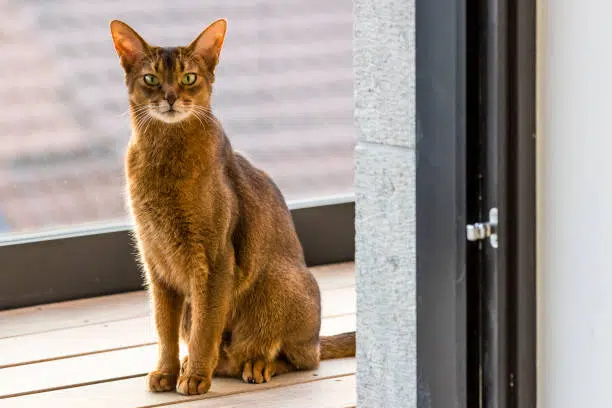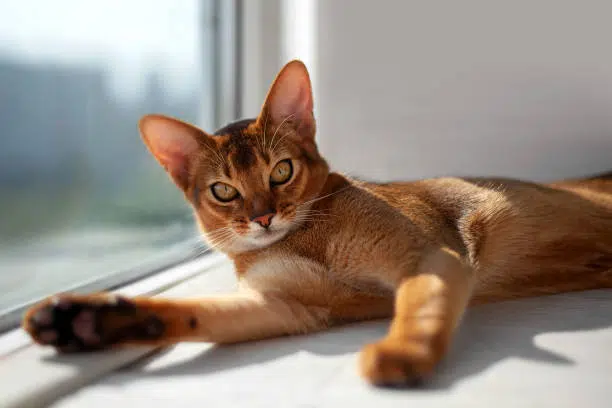Table of Contents
Scientific Classification
| Kingdom | Animalia |
| Phylum | Chordata |
| Class | Mammalia |
| Order | Carnivora |
| Family | Felidae |
| Genus | Felis |
| Species | Felis catus |
| ScientificName | Felis catus (Abyssinian) |
Description
Imagine a cat that embodies grace, intelligence, and an insatiable curiosity—that’s the Abyssinian for you. This breed truly shines with its regal posture, sleek physique, and a stunning ticked coat that glimmers in the light. Abyssinians boast a medium, muscular build and long, elegant legs, while their gently arched neck adds to their sophisticated look. They glide through their surroundings with a quiet confidence that never fails to draw attention.
What really sets them apart is their unique fur. Each strand is “ticked,” featuring bands of various shades that can range from warm ruddy copper to soft blue-gray. This creates a dazzling, wildcat-like effect that’s hard to miss.
Their eyes are large and almond-shaped, sparkling in shades of gold, green, or hazel. With their big ears that tilt forward, they always seem to be listening in on the secrets of the world.
But don’t be fooled by their beauty—they’re bursting with energy and a playful spirit. These little adventurers zip around the house like tiny panthers, constantly on the lookout for their next exploration.
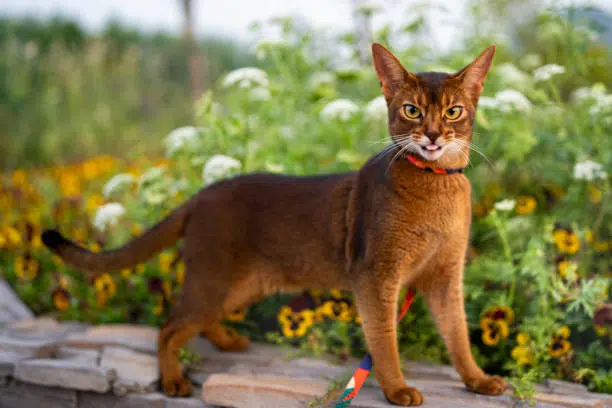
Distribution
The name “Abyssinian” hints at a connection to Abyssinia, which we now know as Ethiopia. Yet, the true roots of the Abyssinian cat remain a topic of debate. Genetic research suggests that their ancestors likely originated from the Indian Ocean coast and Southeast Asia. The breed we recognize today emerged in the United Kingdom during the 19th century, developed from imported cats that bore a striking resemblance to those depicted in ancient Egyptian art.
Today, Abyssinians are beloved pets across the globe. You can find them in places like North America, the UK, Europe, Australia, and Japan.
Habitat
As a domesticated breed, Abyssinians don’t have a natural wild habitat to call their own. Instead, they really flourish in homes that provide plenty of mental stimulation and vertical space. These cats adore high perches with a view—think bookshelves, window sills, and tall cat trees—where they can keep an eye on their surroundings.
They’re big fans of warmth and sunshine, often found lounging in sunbeams or snuggling up in cozy spots near heaters. Abyssinians thrive in environments that keep them both mentally and physically engaged. They enjoy playing with toys, exploring climbing structures, and, most importantly, being around loving humans.
Diet
Abyssinians are true carnivores, which means they rely on animal protein to stay healthy and happy. Their bodies are designed to digest meat efficiently. It’s best to feed your cat high-quality commercial food or vet-approved homemade meals that are packed with meat-based proteins and taurine, an essential nutrient for their well-being.
Both dry kibble and wet food have their benefits, but keeping your cat hydrated is crucial. Since cats don’t tend to drink a lot of water, incorporating wet food or bone broth can really help support their kidney health.
Many Abyssinians enjoy grazing throughout the day, so they thrive on several small meals rather than one big feast. They also love puzzle feeders, which can turn mealtime into a fun mental challenge!
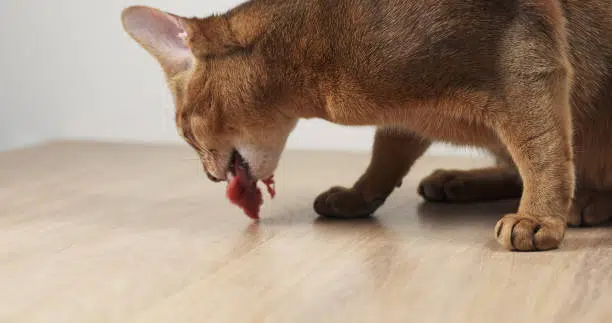
Behavior
If you’ve ever felt like your cat is outsmarting you, there’s a good chance you’re sharing your home with an Abyssinian. These clever little furballs are not only smart but also incredibly curious. They don’t just lounge around on windowsills; they’ll jump right into your lap to see what you’re reading. You might find them climbing onto counters to check out your groceries or even batting at your keyboard while you’re trying to work.
Abyssinians are affectionate without being overly clingy. They form strong connections with their humans, preferring to be close by, observing you, and sometimes even “helping” out with whatever you’re doing.
When it comes to playtime, an Abyssinian takes it very seriously. They can turn a simple bottle cap into a thrilling toy, scale door frames just for fun, and solve treat puzzles in no time. Plus, they have a unique way of communicating. Instead of the usual meow, they often chirp or trill, using these sounds to express their needs or to greet their favorite people.
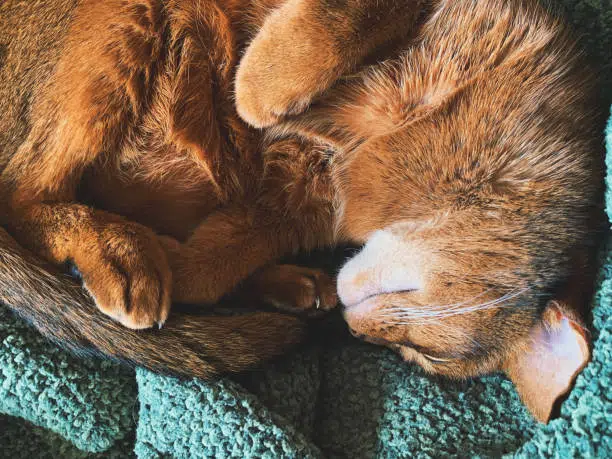
Lifespan
When given the right care, an Abyssinian cat can enjoy a long and vibrant life. Typically, they live between 12 to 15 years, but some lucky ones can even hit the 18-year mark or beyond. Like any breed, they come with their own set of genetic quirks. Responsible breeders work hard to minimize these issues, which include:
– Progressive Retinal Atrophy (PRA) – a genetic eye condition.
– Renal Amyloidosis – a rare disorder that impacts kidney function.
– Gingivitis and other dental problems – which means regular dental care is a must.
To ensure your Abyssinian thrives, make sure they get preventive vet care, a balanced diet, and a lively indoor environment.
Reproduction and Lifecycle
Female Abyssinians, often referred to as queens, typically reach sexual maturity between 5 to 9 months of age, while males, or toms, tend to mature a little later. Responsible breeders usually wait until the cat is around 12 months old before breeding, ensuring that the cat is both physically and emotionally ready for this important step.
The pregnancy period lasts about 63 to 65 days, and litters usually consist of 3 to 6 kittens. When they’re born, the kittens have dark coats, but as they grow, they start to show off their unique ticking patterns.
From a young age, these kittens are lively and playful. It’s crucial to socialize them during their first 8 to 12 weeks. By the time they hit 6 months, they’re physically in their adolescent stage, but it takes about another year for them to reach full mental maturity.
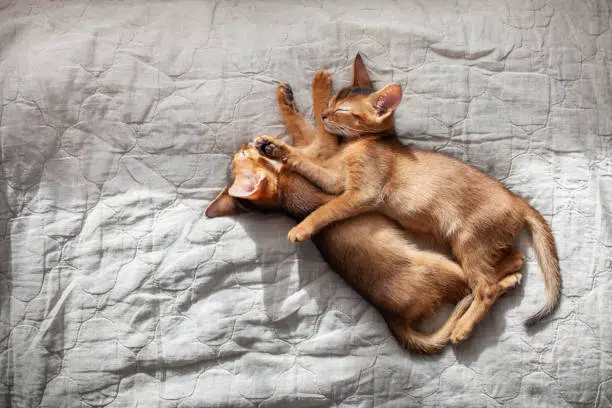
Predators
When it comes to domesticated Abyssinians living indoors, they’re pretty much safe from natural predators. But if they venture outside or if they’re feral, they might encounter some dangers like:
– Coyotes and foxes, especially in rural or suburban neighborhoods
– Large birds of prey, such as owls or eagles
– Dogs, particularly those that are unsupervised or known to be aggressive
– Cars, which are unfortunately the top cause of outdoor cat fatalities
For the happiest and safest life, an Abyssinian really thrives indoors. They can have a taste of the outdoors, but it’s best to do so in secure enclosures or while wearing a harness.
Adaptations
The Abyssinian cat has some fascinating adaptations that reflect both its domestic life and wild ancestry:
Ticked coat: This unique genetic feature not only helps them blend into their natural surroundings but also adds a touch of elegance to their appearance at home.
Sharp senses: With exceptional hearing, keen eyesight, and a strong sense of smell, these cats are natural hunters—whether it’s chasing after toys, spotting bugs, or pouncing on that elusive laser dot.
Social intelligence: Over generations of cohabiting with humans, they’ve developed a remarkable ability to connect, making them affectionate and expressive companions.
They’re also quite in tune with human routines, often knowing just when it’s time to eat, greet you, or settle down for the night.
Mating Season
Did you know that cats are seasonally polyestrous? This means they can go into heat multiple times during the breeding season, which stretches from spring all the way to early autumn. Interestingly, indoor cats that are exposed to artificial light might cycle throughout the year!
When a female Aby is in heat, you might notice some telltale signs:
– Restlessness and pacing around
– Increased vocalization, almost like she’s trying to chat
– Affectionate behavior or rolling around on the floor
– Tail raising and that adorable “kneading” motion
On the other hand, unneutered males can be quite loud and territorial, often trying to roam in search of a mate.
For pet owners who aren’t looking to breed, it’s a good idea to spay or neuter your pets. This not only helps prevent unwanted litters but also reduces the risk of reproductive cancers.
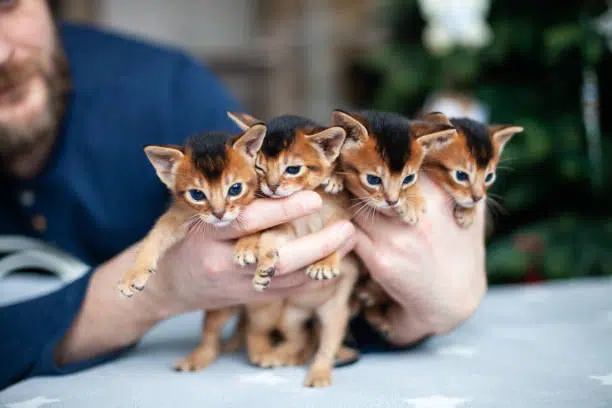
Breeding
Breeding Abyssinians is a responsibility that falls on the shoulders of knowledgeable and ethical breeders. The aim is to produce kittens that not only look stunning but also have friendly personalities. It’s equally important to ensure their genetics remain diverse and healthy.
Responsible breeders take several key steps:
– They screen for genetic disorders, such as PRA.
– They keep detailed records of pedigrees.
– They socialize the kittens from an early age.
– They wait until the cats are fully mature before breeding.
Abyssinian mothers are usually very attentive and gentle. Kittens are typically weaned between 6 to 8 weeks of age and usually stay with their mother until they are about 12 to 14 weeks old. This time spent with their mother is crucial for their development and helps them learn important social skills.
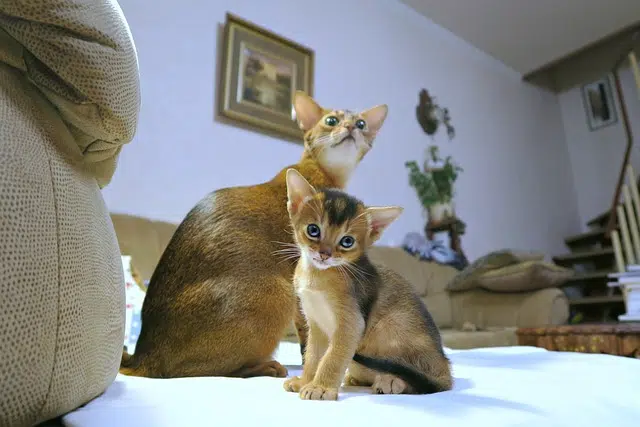
Interesting Facts
- Did you know these interesting facts about Abyssinians?
- Ancient Lookalike: Abyssinians bear a striking resemblance to the cats depicted in ancient Egyptian art, which has sparked some fascinating myths about their royal lineage.
- Quiet Charmers: While they’re not the loudest of cats, they certainly have their own way of communicating with soft chirps and trills that are quite endearing.
- Water Curious: Many Abyssinians have a curious fascination with water and might even want to join you for a shower!
- Highly Trainable: These clever cats can learn to fetch, walk on a leash, and even tackle complex puzzles with a little patience.
- Color Variants: The classic Abyssinian color is ruddy, but they also come in beautiful shades like blue, fawn, and cinnamon, all showcasing that distinctive ticking pattern.
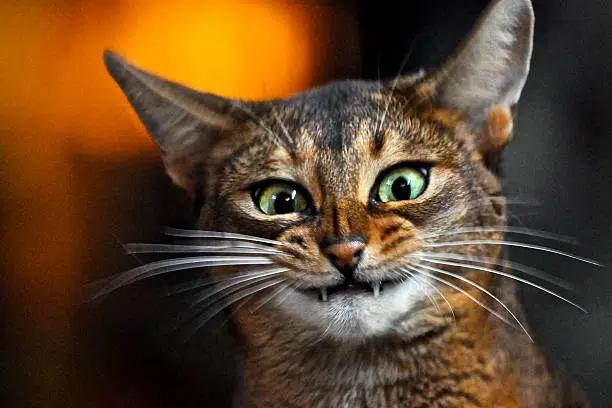
Conservation Status
When it comes to conservation status, the Abyssinian isn’t considered a wild species, so it doesn’t fall under the classifications of conservation organizations like the IUCN. Instead, responsible breeding practices help keep the breed’s genetic health and diversity in check.
Various breed clubs and organizations, including:
The Abyssinian is truly a wonder—a perfect mix of athleticism, grace, and spirit. They don’t just live in our homes; they become a part of our everyday lives. Their lively personalities light up every nook and cranny of the house.
Whether it’s an Aby leaping with elegance, curling up after a long day, or chirping for some attention, life with an Abyssinian is always a delightful adventure. It’s a journey filled with curiosity and affection. Plus, you’ll enjoy the playful challenge of keeping up with one of the smartest cats out there!
…play vital roles in upholding breed standards, conducting health screenings, and promoting ethical cattery practices.
Thanks to these dedicated efforts, the Abyssinian has become one of the most cherished and stable cat breeds around the globe.
Conclusion
The Abyssinian is truly a wonder—a perfect mix of athleticism, grace, and spirit. They don’t just live in our homes; they become a part of our everyday lives. Their lively personalities light up every nook and cranny of the house.
Whether it’s an Aby leaping with elegance, curling up after a long day, or chirping for some attention, life with an Abyssinian is always a delightful adventure. It’s a journey filled with curiosity and affection. Plus, you’ll enjoy the playful challenge of keeping up with one of the smartest cats out there!
